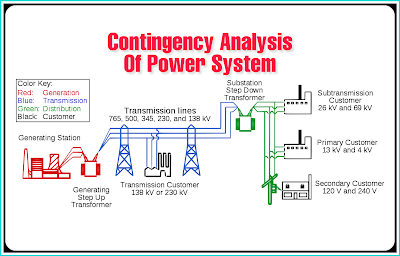What is Contingency Analysis? | Necessity of contingency analysis
 |
| What is Contingency Analysis? | Necessity of contingency analysis |
Contingency Analysis(CA)is one of the "security analysis" applications in a power utility control centre.
Its purpose is to analyze the power system in order to identify the overloads.
Contingency analysis is abnormal condition in electrical network.It put whole system or a part of the system under stress. It occurs due to sudden opening of a transmission line. Generator tripping. Sudden change in generation. Sudden change in load value.
Contingency analysis provides tools for managing, creating, analyzing, and reporting lists of contingencies and associated violations.
CA is used as a study tool for the off-line analysis of contingency events, and as an online tool to show operators what would be the effects of future outages.
- Security is determined by the ability of the system to withstand equipment failure.
- Weak elements are those that present overloads in the contingency conditions(congestion).
- Standard approach is to perform a single(N-1)contingency analysis simulation.
- A ranking method will be demonstrated to prioritize transmission planning.
- CA is therefore a primary tool used for preparation of the annual maintenance plan and the corresponding outage schedule for the power system.
Contingency analysis allows the system to be operated defensively. Many of the problems which occur in the power system can cause serious troubles within a short time if the operator could not take fast corrective action.
Therefore, modern computers are equipped with contingency analysis programs which model the power system and are used to study outage events and alert the operators of potential overloads and voltage violations.
The most difficult methodological problem to cope within contingency analysis is the accuracy of the method and the speed of solution of the model used.
The operator usually needs to know if the present operation of the system is secure and what will happen if a particular outage occurs.
After a contingency event, power system problems can range from:
- None: When the power system can be re-balanced after a contingency, without overloads to any elements.
- Severe: When several elements such as lines and transformers become overloaded and have risk of damage.
- Critical: When the power system becomes unstable and will quickly collapse.
By analyzing the effects of contingency events in advance, problems and unstable situations can be identified, critical configurations can be recognized, operating constraints and limits can be applied, and corrective actions can be planned.
Let us consider than n power system components are there in a power system, and if one component, i.e. one generator or a one line in a transmission system fails or outage (single failure), then this event is called n - 1 contingency analysis.
Whereas if two components, i.e.two lines in a transmission system or, a generator and a transmission line in the system fail or, outage (two failures), then this event is called n - 2 contingency analysis.
The contingency analysis procedure is given with a flow chart as shown in below figure:
NECESSITY OF CONTINGENCY ANALYSIS:
Improving system reliability:
In a developing country like India,we are already facing huge amount of load shedding. There have been a number of reforms in the power sector in India. But government reforms failed to bring desired improvements in the power sector.
On the other hand, we are loosing transformers and generators for security violation or for some overload problem, or a bus voltage outside the limit. It means that if we aren't able to maintain our existing generator or network properly it might be a great loss of our valuable property.
With the help of contingency analysis we will be able to know the raking by which helps us to known the amount of losses for any fault in bus, generator, transformer and transmission line. So we must have to be aware to solve the problem before they arise.
For secured operation:
As we can determine early by using this method that which components are risky and have probability to fail in near future so we can be more aware about those components and can take additional steps of maintenance to protect it.
That means, we can operate components of the power system more safely and effectively utilizing this analysis.
For future planning and expansion:
If fault occurs in any transmission line then the load flow through the rest of the lines in the system and this process will increase pressure on those lines.
To avoid such problem we can run contingency analysis helps us to expand
transmission line and improve future power system.


Very nice post. It is very informative and useful for the electricians. Also, you can get services from the leading local builders in London
ReplyDelete